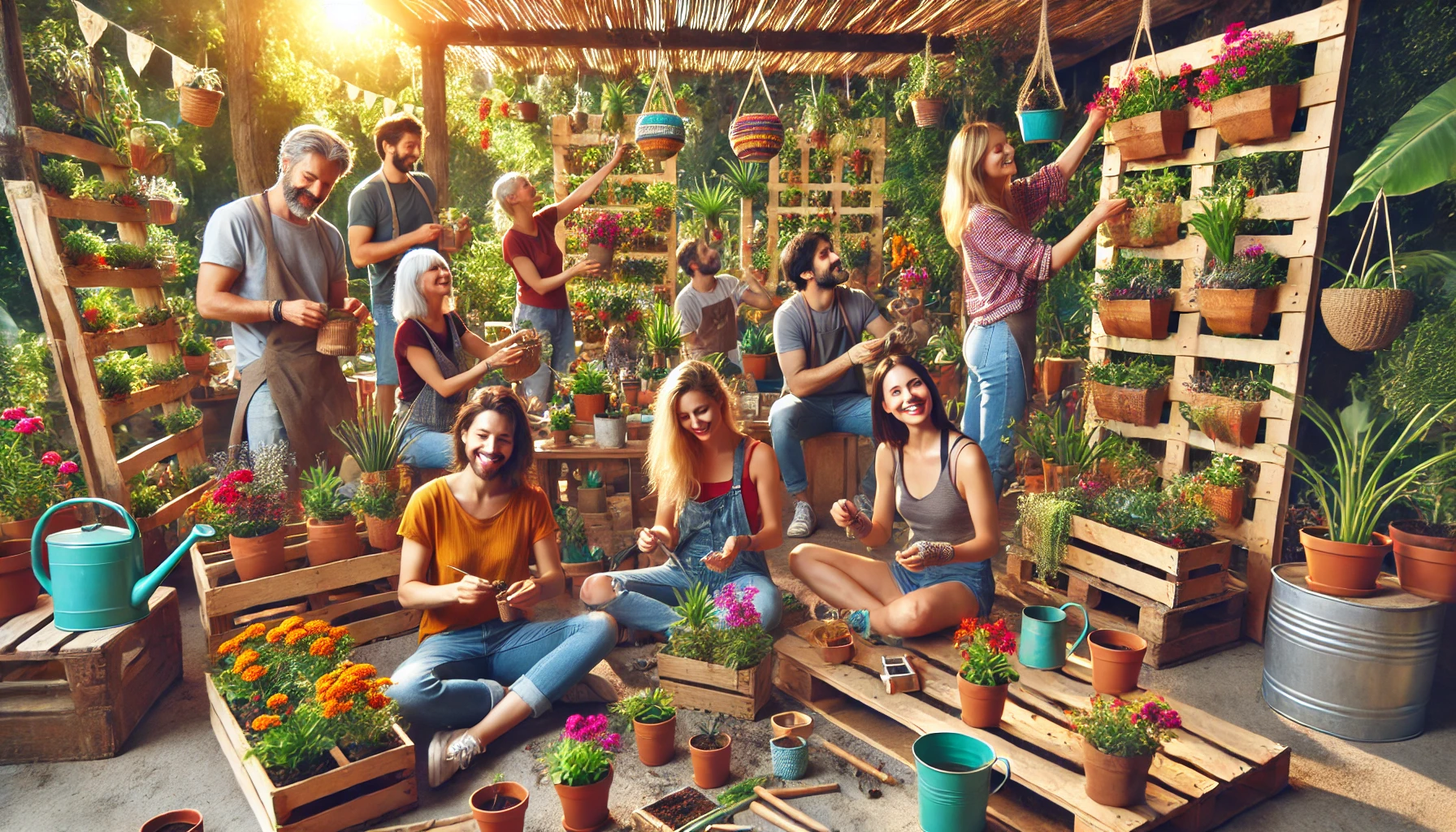Make Your Own Vertical Planter and join the trend that’s capturing the hearts of urban gardening enthusiasts everywhere. These unique plant arrangements are crafting waves not just for their eye-catching style but for their smart use of space – a real game-changer for those short on square footage.
Vertical planters aren’t just about maximizing greenery in tight spots, though. They’re a splash of life on any balcony or garden wall, bringing that lush, green vibe to places you wouldn’t jam a typical potted plant.
The charm of vertical planters also lies in their ability to turn any dull corner into a little sanctuary that’s both beautiful and functional. Imagine stepping onto your patio and being greeted by a wall of herbs or vibrant flowers. It’s like art that grows!
The DIY Approach: Create Your Own Vertical Garden
Making a DIY vertical garden is all about creativity and practicality, not to mention a whole lot of fun. The first thing you’ll need is a sturdy frame or wall. Think wooden pallets, unused picture frames, or even a wire mesh could do the trick. The goal is to have something solid that can hold the weight of the soil while giving your plants all the room they need to spread out.
When it comes to materials, the good news is you probably have most of what you need at home or can find it cheaply at a local store. Gather up some potting soil, a few hooks or nails, and definitely some waterproof fabric if you’re planning to hang it indoors. Keep it simple and safe – no need for power tools unless you’re itching for a little DIY thrill.
What about plants, you ask? Go for the versatile type. Succulents, herbs like mint and basil, or flowering plants like petunias are all awesome choices. They’ll thrive in a vertical setup and add just the right splash of color and aroma. Set these into pockets or containers that can be affixed to your structure.
Location matters, too. Pick a spot that gets adequate light but isn’t too exposed, unless your plants love the sun. Install a basic drip watering system or just remember to water regularly. This setup works wonders in keeping your green friends hydrated without drenching them or your floor.
Cost Analysis: Is Making Your Own Planters Cheaper?
Digging into the cost of making your own planters versus buying them can be a real eye-opener. DIY options often come out on top when you tally up the savings, especially if you’re resourceful about sourcing materials.
Think about it—those trendy store-bought vertical planters tend to come with a hefty price tag, likely due to the design and convenience factor. Crafting your own allows for much more control over the budget. Loads of materials, like old pallets or recycled containers, are either low-cost or free. An old dresser or a set of plastic soda bottles even can find new life as planters.
The key is in the creative reuse of stuff just lying around. With some simple tools and a bit of imagination, you can build a planter that’s perfect for your space and your wallet.
Consider the long-term, too. Making your own planter means easier repairs and customizations down the line. Need more planters for new plants? Just whip up another with what you’ve learned.
Remember, the goal is not just about cheap—it’s about creating something that fits your style and needs without breaking the bank.
Maximizing Plant Growth: Techniques for Vertical Success
Getting plants to grow vertically is like giving them a new direction, literally. Key to this is picking the right plants and giving them the support they need to climb. Vines, tomatoes, and cucumbers are pros at this and will naturally head upwards if you guide them.
Creating a supportive environment starts with your choice of soil. Good-quality, light potting soil works wonders—it’s like a cushy mattress for your plants where roots can dig in without much hassle. Just don’t pack it too tight, or you might end up with frustrated plant roots and poor drainage.
Regular watering is crucial—but think efficient. You don’t want to flood your plants, especially in a vertical setup, where gravity does some of the work. A drip irrigation system can be your best friend, delivering water just where it’s needed and saving you time and water.
Sunlight! Or shadows at least. Pay attention to where sunlight falls throughout the day and position your planter accordingly. Some plants need a full day of basking, while others thrive with just half. Move things around, give them the light they crave, and watch them grow.
Hydroponic setups are also worth exploring if you’re into high-tech gardening. These systems deliver nutrients directly to the roots through a water-based solution, eliminating the soil altogether and letting plants grow impressively up and out.
Vertical success is all about keeping an eye on what your green pals are telling you—wilted leaves, stunted growth, or yellowing? Adjust your care, give them a boost, and soon enough, you’ll have a flourishing vertical garden.
Understanding the Drawbacks of Vertical Gardens
As much as we love vertical gardens for their ingenuity, they’re not without a few hiccups. A primary concern is the root space—or lack thereof. Plants in vertical setups often vie for limited soil, impacting their growth. Choosing smaller plants or those with shallow root systems can help mitigate this.
There’s also the question of maintenance. While a vertical garden might seem low-maintenance compared to a sprawling traditional garden, it does require some regular attention. Ensuring that each plant gets enough water without oversaturating the frame can be tricky, so automated irrigation systems can be a lifesaver.
Environmental factors, such as wind and temperature extremes, play a significant role, too. Walls and frames can offer some shelter, but they also put plants in more direct exposure at times. Picking hardy or suitable local plant varieties can make a big difference.
Water usage can spike if you’re not careful. Drip systems are efficient, but without one, the manual task of watering can add to your home’s water bill and contribute to excessive runoff. Making sure the setup is as water-efficient as possible is key.
Finding a balance between aesthetic and functionality is part of the challenge of vertical gardening. When done right, these gardens can reflect well on an eco-friendly lifestyle while enhancing any space with vibrant life.

Concluding Thoughts: Embrace the Vertical Gardening Trend
Vertical gardening is more than a trend; it’s a fresh approach to bring more greenery into our living spaces. We’ve explored the upsides and a few bumps along the road of creating your own vertical planter, highlighting its space-saving nature and creative potential.
This journey into vertical gardening encourages a hands-on approach, inspiring you to experiment with design and plant choices. Whether you’re repurposing materials or customizing your layout for specific plants, the creative possibilities are boundless.
For those taking the plunge into this gardening adventure, remember you’ve got the flexibility to play around with setup and choices. Be proud of every tiny bloom and fresh herb that thrives up there – it’s a testament to your innovation and care.
Tending to your vertical garden is an ongoing project. It might need tweaking with seasons, and that’s part of the fun. Stay curious and enjoy watching your garden evolve as you learn more about what works best in your unique space.
Remember, vertical gardening combines art, gardening know-how, and a splash of sustainability. Embrace the opportunity to transform your walls into living canvases, offering a green escape and new dimensions to your surroundings.


Great article! Your step-by-step guide makes building a vertical planter feel very achievable, even for those who may not have much DIY experience. I love how you’ve outlined the process in a clear and practical way, making it easy to follow along. The variety of planter ideas also offers great inspiration for different spaces and styles.
How do you prevent water runoff from damaging walls or surfaces when installing a vertical planter indoors? Are there specific drainage solutions or materials you’d recommend to help manage excess moisture while still keeping plants healthy? I’d love to hear your thoughts on the best ways to maintain an indoor vertical garden without worrying about potential water damage!
Thank you for your kind words! I’m glad you found the guide helpful. To prevent water runoff indoors, using a waterproof backing, drip trays, or self-watering planters can help manage excess moisture. Felt pocket planters with built-in moisture barriers are also a great option. Adding a well-draining soil mix and watering carefully can further minimize runoff. Let me know if you need specific recommendations!
This is such an inspiring guide to vertical gardening! I love how it not only saves space but also adds a fresh, green aesthetic to any area. The DIY approach makes it even more appealing—repurposing materials like old pallets and picture frames is a great way to keep costs down while staying eco-friendly. I’m especially intrigued by the idea of using a drip watering system to keep plants hydrated efficiently.
One challenge I’ve heard about with vertical gardens is ensuring that all plants get adequate water and nutrients, especially in stacked or wall-mounted setups. Have you found any specific methods or materials that help distribute water more evenly, preventing dry spots or overwatering certain sections?
Thank you so much! I’m really glad you found the guide inspiring. Vertical gardening is such a great way to maximize space while bringing more greenery into any environment. Plus, the DIY aspect makes it fun and budget-friendly!
You bring up a great point about water distribution in vertical gardens. One of the most effective solutions I’ve found is using a drip irrigation system with adjustable emitters, which allows you to control the flow rate for different sections. Another great method is using a wicking system with felt or coconut coir liners to help retain moisture and distribute it more evenly across the setup. Also, incorporating a well-draining yet moisture-retentive soil mix can help prevent dry spots.
If you’re setting up a vertical garden, I’d love to hear about your experience and what plants you’re thinking of growing!